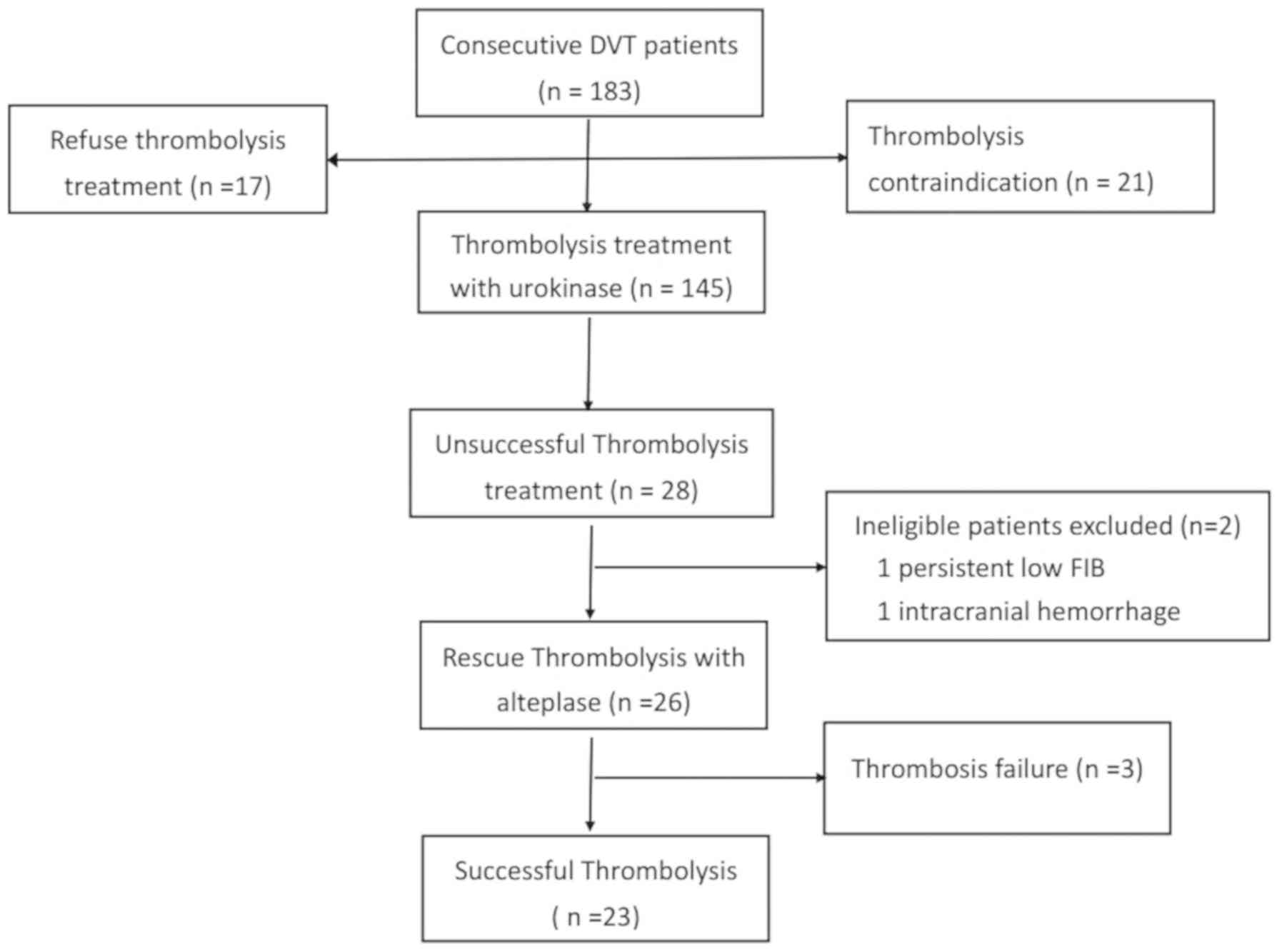|
1
|
Kearon C: Natural history of venous
thromboembolism. Circulation. 107 (Suppl 1):S122–S130. 2003.
View Article : Google Scholar
|
|
2
|
Kearon C, Akl EA, Ornelas J, Blaivas A,
Jimenez D, Bounameaux H, Huisman M, King CS, Morris TA, Sood N, et
al: Antithrombotic therapy for VTE disease: CHEST guideline and
expert panel report. Chest. 149:315–352. 2016. View Article : Google Scholar : PubMed/NCBI
|
|
3
|
Haig Y, Enden T, Grøtta O, Kløw NE,
Slagsvold CE, Ghanima W, Sandvik L, Hafsahl G, Holme PA, Holmen LO,
et al: Post-thrombotic syndrome after catheter-directed
thrombolysis for deep vein thrombosis (CaVenT): 5-year follow-up
results of an open-label, randomised controlled trial. Lancet
Haematol. 3:64–71. 2016. View Article : Google Scholar
|
|
4
|
Watson L, Broderick C and Armon MP:
Thrombolysis for acute deep vein thrombosis. Cochrane Database Syst
Rev. Nov 10–2016.(Epub ahead of print). doi:
10.1002/14651858.CD002783.pub3. View Article : Google Scholar
|
|
5
|
Gurman P, Miranda OR, Nathan A, Washington
C, Rosen Y and Elman NM: Recombinant tissue plasminogen activators
(rtPA): A review. Clin Pharmacol Ther. 97:274–285. 2015. View Article : Google Scholar : PubMed/NCBI
|
|
6
|
Meneveau N, Seronde MF, Blonde MC,
Legalery P, Didier-Petit K, Briand F, Caulfield F, Schiele F,
Bernard Y and Bassand JP: Management of unsuccessful thrombolysis
in acute massive pulmonary embolism. Chest. 129:1043–1050. 2006.
View Article : Google Scholar : PubMed/NCBI
|
|
7
|
Vedantham S, Sista AK, Klein SJ, Nayak L,
Razavi MK, Kalva SP, Saad WE, Dariushnia SR, Caplin DM, Chao CP, et
al: Quality improvement guidelines for the treatment of
lower-extremity deep vein thrombosis with use of endovascular
thrombus removal. J Vasc Interv Radiol. 25:1317–1325. 2014.
View Article : Google Scholar : PubMed/NCBI
|
|
8
|
Decousus H, Leizorovicz A, Parent F, Page
Y, Tardy B, Girard P, Laporte S, Faivre R, Charbonnier B, Barral
FG, et al: A clinical trial of vena caval filters in the prevention
of pulmonary embolism in patients with proximal deep-vein
thrombosis. Prévention du Risque d'Embolie Pulmonaire par
Interruption Cave Study Group. N Engl J Med. 338:409–415. 1998.
View Article : Google Scholar : PubMed/NCBI
|
|
9
|
Chen G, Shi W, He X, Lou W, Chen L and Gu
J: Feasibility of continuous, catheter-directed thrombolysis using
low-dose urokinase in combination with low molecular-weight heparin
for acute iliofemoral venous thrombosis in patients at risk of
bleeding. Exp Ther Med. 13:751–758. 2017. View Article : Google Scholar : PubMed/NCBI
|
|
10
|
Shi WY, Gu JP, Liu CJ, He X and Lou WS:
Endovascular treatment for iliac vein compression syndrome with or
without lower extremity deep vein thrombosis: A retrospective study
on mid-term in-stent patency from a single center. Eur J Radiol.
85:7–14. 2016. View Article : Google Scholar : PubMed/NCBI
|
|
11
|
Farraj RS: Anticoagulation period in
idiopathic venous thromboembolism. How long is enough? Saudi Med J.
25:848–851. 2004.
|
|
12
|
Kahn SR, Shapiro S, Wells PS, Rodger MA,
Kovacs MJ, Anderson DR, Tagalakis V, Houweling AH, Ducruet T,
Holcroft C, et al: Compression stockings to prevent post-thrombotic
syndrome: A randomised placebo-controlled trial. Lancet.
383:880–888. 2014. View Article : Google Scholar : PubMed/NCBI
|
|
13
|
Mewissen MW, Seabrook GR, Meissner MH,
Cynamon J, Labropoulos N and Haughton SH: Catheter-directed
thrombolysis for lower extremity deep venous thrombosis: Report of
a national multicenter registry. Radiology. 211:39–49. 1999.
View Article : Google Scholar : PubMed/NCBI
|
|
14
|
Haig Y, Enden T, Slagsvold CE, Sandvik L,
Sandset PM and Kløw NE: Determinants of early and long-term
efficacy of catheter-directed thrombolysis in proximal deep vein
thrombosis. J Vasc Interv Radiol. 24:17–24. 2013. View Article : Google Scholar : PubMed/NCBI
|
|
15
|
Buller HR, Davidson BL, Decousus H, Gallus
A, Gent M, Piovella F, Prins MH, Raskob G, van den Berg-Segers AE,
Cariou R, et al: Subcutaneous fondaparinux versus intravenous
unfractionated heparin in the initial treatment of pulmonary
embolism. N Engl J Med. 349:1695–1702. 2003. View Article : Google Scholar : PubMed/NCBI
|
|
16
|
Vedantham S, Piazza G, Sista AK and
Goldenberg NA: Guidance for the use of thrombolytic therapy for
thetreatment of venous thromboembolism. J Thromb Thrombolysis.
41:68–80. 2016. View Article : Google Scholar : PubMed/NCBI
|
|
17
|
Gao B, Zhang J, Wu X, Han Z, Zhou H, Dong
D and Jin X: Catheter-directed thrombolysis with a continuous
infusion of low-dose urokinase for non-acute deep venous thrombosis
of the lower extremity. Korean J Radiol. 12:97–106. 2011.
View Article : Google Scholar : PubMed/NCBI
|
|
18
|
Sugimoto K, Hofmann LV, Razavi MK, Kee ST,
Sze DY, Dake MD and Semba CP: The safety, efficacy, and
pharmacoeconomics of low-dose alteplase compared with urokinase for
catheter-directed thrombolysis of arterial and venous occlusions. J
Vasc Surg. 37:512–517. 2003. View Article : Google Scholar : PubMed/NCBI
|
|
19
|
Chang R, Chen CC, Kam A, Mao E, Shawker TH
and Horne MK III: Deep vein thrombosis of lower extremity: Direct
intraclot injection of alteplase once daily with systemic
anticoagulation-results of pilot study. Radiology. 246:619–629.
2008. View Article : Google Scholar : PubMed/NCBI
|
|
20
|
Manninen H, Juutilainen A, Kaukanen E and
Lehto S: Catheter-directed thrombolysis of proximal lower extremity
deep vein thrombosis: A prospective trial with venographic and
clinical follow-up. Eur J Radiol. 81:1197–1202. 2012. View Article : Google Scholar : PubMed/NCBI
|
|
21
|
Fiengo L, Bucci F, Khalil E and Salvati B:
Original approach for thrombolytic therapy in patients with
Ilio-femoral deep vein thrombosis: 2 years follow-up. Thromb J.
13:402015. View Article : Google Scholar : PubMed/NCBI
|











